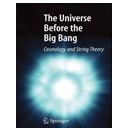Before the Big Bang
If the big bang marked the beginning of our universe, then what existed before it? The four-part documentary series titled Before the Big Bang explores various theories which seek to explain this intriguing mystery.
We know that hundreds of billions of galaxies exist in our universe, but what are the odds that other universes existed previous to our own? Top cosmologists, astronomers and assorted scientists are working feverishly on developing these answers. Together, their individual breakthroughs represent crucial incremental steps in the search for expanding knowledge of our universe.
The first segment - Loop Quantum Cosmology - illustrates one such journey for greater understanding. By challenging and broadening the tenants of Einstein's Theory of General Relativity, scientists hope to gain greater insights into the interactions between subatomic particles. Also introduced in this segment is the notion of the multiverse, an infinite plane of interconnecting alternate universes including and beyond our own.
The second segment - titled Conformal Cyclic Cosmology - calls upon the work of Professor Sir Roger Penrose, an influential physicist whose theories regarding the pre-history of our universe have received garnered equal measures of acclaim and skepticism. Utilizing the Second Law of Thermodynamics, Penrose has questioned the non-existent role that gravity played in the big bang. Could this point to a prior universe?
One of the most recent approaches to explaining existence prior to the big bang is also one of the most popular - a hybrid of the fields of string theory and cosmology. Featuring interviews with acclaimed cosmologists David Wands, Dr. Ali Nayeri and others, this branch of research serves as the central topic of the documentary's third segment, String Theory Cosmology, and explores how this approach might be better suited to explain the relationships between particles, forces and structures in the universe prior to its widely accepted origin.
Eternal Inflation and the Multiverse is the title of the fourth segment. The focal point is the work done by Dr. Alan Guth, Professor of Physics at MIT and the founder of the inflationary theory.
Adorned with intensely intelligent interview subjects and appealing 3D animations, Before the Big Bang makes an admirable attempt at simplifying a series of complex scientific theories. Regardless, the layperson may still find the material challenging in its immense scope and density.




They are getting as crazy as religious leaders
Most things in nature have cycles. "IF" the universe is expanding now, doesn't mean it always will be. For all we know its galaxies are on an elliptical orbit around Mother Universe. (A few gals I know admit the whole world revolves around them ;) That would make them appear to be growing further apart at times and getting closer at another epoch in time.
Shame on us if any of these blokes are getting a dime in tax dollars.
The Big Bang Shattered Absolute Zero.
My brain hurts.
I'm not sure I have this right, but what I think is being said is, A previous universe came into being that was an unstable balance of universal constants, and when it began to oscillate (crunch-expansion cycle) the constants eventually balanced enough to create a non-collapsing universe. Our universe.
Though, that doesn't explain how the primary event occurred.
What about the Orange Theory instead the big crunch theory?
Just the title puts me off.
Before the Big Bang? Space-time started to exist then. There is no "before" the Big Bang. Time did not exist.
Checking the video out, so far... meh.
Unwatchable due to the crappy quality of the sound.
Mark, I really liked the idea of Protospace, it all has to be one, matter and space, although how it becomes distinguishable as space and matter is still a mystery to me!
Jeez get a mic will you..
All is well, your theoretical physics are awesome.
As an irrefutably awesome Mom, I used a small heavy steel ball and made a 'dent' in my bedspread to teach my kids a bit about the event horizon. :)
Bang! my brain exploding
Protospace has no reference of time because it has no beginning or end. Time is only an arbitrary measurement of duration. Without a beginning or end, there is nothing to measure. However, if an event occurs within Protospace, that is a reference point that can be measured from, but it would only be an arbitrary measurement, not a physical component of the event itself. Time is simply a vector, no different from the measurements of direction or position. In other words, time is only an invented arbitrary measurement of duration, just as an inch is only an invented arbitrary measurement of length, neither cause nor effect what they measure.
The physical volume composing Protospace does not have or need any other structures or dimensions to physically exist. Protospace cannot have a beginning because something cannot come into existence within a greater context of nonexistence, and Protospace cannot have an end because substance cannot compose nothingness. Protospace is simply a spatial homogeneous continuum of a single substance...
Predictions is what scientists do when they do not know what they are doing. I do not make predictions. However, I do have a complete mechanical map of the universe’s formational processes from Protospace to self-replicating DNA. I use just one substance, with just one force to construct the totality of both the physical universe (space,) and the material universe (matter, energy, gravity, and magnetism.)
As you can see in my post above, I did quantify physical space to absolute mechanical terms in the equation ∞Cᶠ=1³x∞. It is not a prediction; it is a fact. However, the equation is incomplete, it needs a force to be an active substance.
Force:
Protospace is a spatial continuum of a single homogeneous substance with a density of 1³x∞. In a static state, it is inert, meaning that it has no active force. Without a force, Protospace would remain a static continuum. Since Protospace must exist before matter and energy, the ability to generate matter and energy must be a byproduct of Protospace; there is simply nowhere else for matter and energy to come from. In other words, matter and energy must be made from the same stuff that Protospace is made of. Therefore, there must be an intrinsic force to cause the formulation of matter and energy.
The only factor that can change in Protospace is density. Density can only change within a finite volume. Mass must be fluidic and have motion to be able to change in density. The only force, that could cause the substance of Protospace to change in density, is a magnetic propensity towards itself. There is simply no other internal function that is actionable that can alter its density.
A single homogeneous substance can only produce a single substantive force. Magnetic propensity only has one of two possible dynamic forces that it can exert; either an attraction or a repulsion, it cannot be both ways because each is opposite to the other, and would cancel out one-another. Three simple analysis questions can be used to determine which magnetic propensity is correct.
Analysis one: A repulsive force:
If a finite volume (a bubble) of density were repulsive towards a greater or lesser density of itself, Protospace would not be able to formulate density differentiations. Any attempt to generate a finite volume of either greater or lesser density would be resistant to itself and remain in an inert state. There would not be a generative force. The substantive fabric of Protospace would remain in an eternal ambient state. This is not conducive towards generating a material universe.
Analysis two: An attractional force towards lesser density:
If a finite volume (a bubble) of 'lesser density' existed within Protospace, and magnetic attraction was towards the lesser density, Protospace would attract into the volume of the lesser density, increasing its density until equalizing with the ambient background density. As well, if a finite volume of 'greater density' existed within Protospace, the greater density would also attract into the ambient lesser density, diffusing until equalizing. Attraction towards lesser density fills in the lesser density until equalized to the ambient density. If magnetic propensity were attracted towards lesser density, any differentiation would always equalize back to the ambient background density. There would not be a productive generative force. Protospace would eternally remain in an ambient state. This is not conducive towards generating a material universe.
Analysis three: An attractional force towards greater density:
If a finite volume (a bubble) of ‘greater density’ existed within Protospace, and lesser density is attracted towards greater density; that would result in a perpetual attraction of the lesser ambient background density into the volume of the greater density; generating progressively greater densities. As well, if a finite volume of ‘lesser density’ existed within greater density, the volume of lesser density would attract towards the greater ambient density, and equalize into the ambient background density. This allows for both condensation and diffusion of density. If density has attraction towards greater density, any differentiation of density would cause a perpetual attraction of lesser density into the greater density. This is a generative force, which is conducive towards generating a material universe.
Therefore, the magnetic propensity of Protospace must be a linear monomagnetic-attraction towards a greater density of its composing substance. In other words, the substance composing Protospace must be magnetically attracted to a greater density of itself. This linear monodynamic force is called Monomagneticattraction.
Monomagneticattraction is the causational force that ultimately composes the material universe. It is simply a magnetic attraction towards a greater magnetic density. Monomagneticattraction is the only force needed to build the totality of the material universe. Protospace is one substance with one force; it has no other physical constructs, dimensions, or substantive causation.
Quantifying substance and force:
The density of mass, combined with the force of Monomagneticattraction is called Magneticmagnitude, and is notated as “Mᵐ.” “M” represents its magnetic potential, and “m” represents its density of mass; expressed as magnetic density of mass. Thus, the ambient density of Protospace is substantively quantified as 1Mᵐ. Adding Mm to the foundational equation of Protospace (∞Cᶠ=1³x∞,) and the equation then becomes ∞Cᶠ=1Mᵐx∞, which defines the dynamic potential of its substantive force.
The ambient density of Protospace is 1Mᵐ. If a finite volume magnetically increases in mass, its density also progressively increases, 1Mᵐ becoming 2Mᵐ, then 3Mᵐ, and then 4Mᵐ etcetera. Magneticmagnitude (Mᵐ) mechanically quantifies the mass and Monomagneticattraction at any point within a finite volume.
The substance composing Protospace is a monolithic continuum that functions like a fluidic solid. Protospace is a solid because it is a static monolithic homogeneous continuum, but it is also fluidic because Monomagneticattraction is a dynamic force that causes motion and density variations within finite amounts of its monomagnetic substance. Mechanically, Protospace is a solid when static, and fluidic when in motion.
Deciphering the physical volume composing the universe is the first question before anything else. Volume is the most abundant aspect of the universe, and thus, its existence is the most paramount issue in understanding the nature of the universe. The spatial volume composing the physical universe must be physically quantified before any comprehension of the material universe can occur. The physical quantification of volume (Protospace,) is a four dimensional Monomagnetic homogeneous continuum of a single volume, substance, and force.
Protospace is an elastic homogeneous continuum of substance. It is one substance, with one force composing the totality of the physical and material universe. Protospace is the eternal and elemental causational foundation of physical existence in all its forms and manifestations. In the beginning, there was one; and all that exists comes from that one; and in all its expressions, is always still but one.
Protospace does not have any other structural characteristics; no multidimensional or parallel space, no time or curved space, no inflation of space, and no quantum foam or strings. It has no constructs of super-physical, supernatural, or any other non-physical properties. Protospace is simply a single substantive continuum of physical volume. It does not get any simpler than that.
Had the Greeks considered the physical volume composing space as a single substantive homogeneous continuum, they would have readily deciphered the properties of physical-volume as a type of substantive proto-space, they themselves might have even called it Protospace; this is because there is no other possible alternative, other than magic. In factual reality, physical existence, on any level, requires a physical causation. Protospace is that physical causation; it is the origin of the universe.
Protospace is based on a simple straightforward tangible fact, “physical volume;” you only need wave your hands about to prove that it exists. That which physically exists, can be observed, measured and quantified…
I am sorry for taking so long to solve this problem, which causes my answer to remain incomplete. We have all been searching for the answer in the wrong area. We were assuming that the big bang theory was a fact; that it must have happened at a pafticular instant in time. This assumption led me down an erroneous path. There is no path to verify or disprove the veracity of the big bang theory without first learning what time really is. Because we find it so difficult to imagine ANYTHING that has no begining or end, we have been impeded in our search for understanding the problem, and therfore the solution. To continue seeking the "big bang" it is necessary to understand that it is mostly in error. We were assuming that as we considered that the universe began at a specific historical time. At least, that was what l believed for most of my life. But as we consider the very possibility that the universe continues to shrink as it approaches that instant, it is not necessary for it to become non existant. It very well may continue to shrink in size. If it continues to shrink forever, it should become infinitly small. This may be merley an indication that we don't understand what time is.
@Mark Maloney : Can you make any predictions about new physics, or get any quantifiable agreement with experiments using your protospaces?
Just read the numerous cultural Myths of Creation. They all claim an eternal Universe where changes takes place for eternity.
All ancient stories of creation only speaks of the pre-formation and factual formation of the Milky Way and the Solar System and NOT of the entire Universe. Read for instants the Egyptian creation story, the Ogdoad.
Besides this. The observation of "The Great Attractor" location around which everything in the visible Universe seems to be orbiting and attracted towards, directly contradicts the very idea of an expanding Universe.
Quantifying Protospace:
Protospace is an absolute constant, infinity minus any number is still infinity; because of this, the substance composing Protospace has a special notation of "∞Cᶠ" to represent its quantitative structure. This is based on the premise: Protospace is infinite in volume and substance, notated as "∞;" it is defined by the structural logic of the CLE Laws, notated as "C;" and it is in a static state defined as a field or continuum, notated as "f," therefore quantitatively expressed as ∞Cᶠ (InfiniteCfield.)
Since Protospace is a single homogeneous continuum of substance and volume, it represents a single volume unit of mass. And because, the infinite substance and volume composing Protospace are real physical quantities, both can be mathematically quantified as 'one cubed, times infinity' (1³x∞.) One cubed is the quantifiable (working) value, and infinity is the constant. The homogeneous mass of Protospace is 1³x∞, thus the ambient density of its substance is also 1³x∞. Therefore, the volume, mass, and density of the substance composing Protospace can be quantified as ∞Cᶠ=1³x∞
This simple equation provides the foundational mechanics that compose the physical universe.